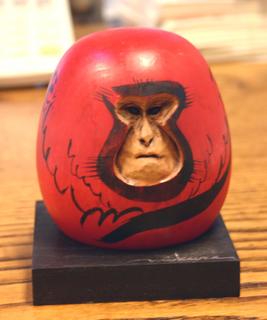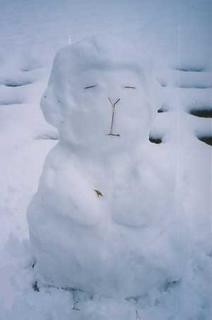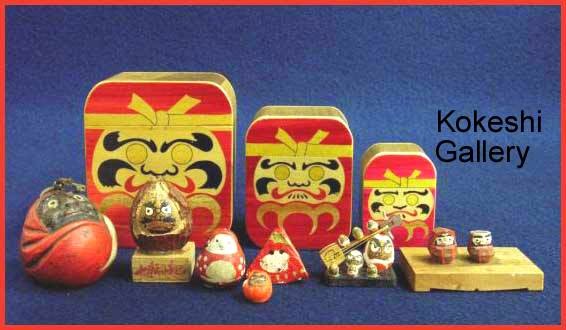- for 大山祇神 Oyamatsumi see below
:::::::::::::::::::::::::::::::::::::::::::::::::::::::::::::::::::::::::::::::::::::::::::::::::::::
Daruma from Mishima Shrine
三島大社の恵比寿の起き上がりだるま
In the form of the God of Good Luck, Ebisu.
Ebisu is the main deity venerated at Mishima Shrine.

http://www.asahi-net.or.jp/~SA9S-HND/agal-938-1.html
This kind of papermachee doll is not produced any more.
. Ebisu えびす 恵比寿 .
:::::::::::::::::::::::::::::::::::::::::::::::::::::::::::::::::::::::::::::::::::::::::::::
The Great Shrine at Mishima
三嶋大社、三島大社 Mishima Taisha
It is not clear exactly when and by whom the Shrine was founded , though it seems to have already existed in the Nara Period (710-794). Records indicate that the 55th Emperor Montoku (827-856) conferred an official rank on the Shrine in 850 and the 56th Emperor Seiwa (850-880) upgraded the rank in 859. At one point, it held the No. 1 position of the shrine list in the Izu Peninsula and it still retains the status as the most authoritative in the area.
In the Edo Period (1603-1868), Mishima became an important post-town of the 503-kilometer-long Tokaido Highroad connecting Tokyo to Kyoto. Travellers who were to go over or came down from the 15-kilometer-long steep Hakone mountains usually stayed in Mishima, and the Mishima post-town prospered with a horde of tour groups. Under the Tokugawa Shogunate rule, Daimyo, or feudal lord, of each prefecture had to live one year in Tokyo and the next in his home prefecture leaving his family in Tokyo as hostage.
On the occasion that a Daimyo went up to Tokyo or came back home for the alternate-year residence system, an entourage of more than 100 men followed him, making a long line of procession. This system helped develop traffic flows throughout Japan and the Tokaido Highroad was the busiest one. (Daimyo's travel was so gorgeous that even today, travelling in a very expensive way is dubbed "Daimyo travel.")
Really, Mishima was one of the most popular post-towns of old-time 53 stages on the Highroad.

Reas more about the history of this famous shrine
http://www.asahi-net.or.jp/~QM9T-KNDU/mishima.htm
More pictures about the Shrine
http://tencoo.fc2web.com/jinja/xmishima.htm
日本語
http://www.mishimataisha.or.jp/
:::::::::::::::::::::::::::::::::::::::::::::::::::::::::::::::::::::::::::::::::::::::::::::::::::::
origami shinzoo 折紙神像
deities made from folded paper

source : miyagemon
From the Shrine 伊豆国一宮
The deities are Ebisu and Daikoku.
The fishing pole of Ebisu is made from twisted paper.
Ebisu is venerated here as the God of Good Luck, and his pal, Daikoku, is added for more good luck in Mishima.
The main deity of the shrine is a protector of trees and the forest
Ooyamatsuminomikoto 大山祇神, 大山積神, 大山津見神
Oyama Tsumi no Mikoto
and
Fukutoku no kami 福徳の神 God of Good Luck (Ebisu)
. Kotoshironushi no kami 事代主命 .
 quote
quoteŌyamatsumi [Ōyamatsumi no kami] (Kojiki)(Nihongi)
According to Kojiki, one of the deities produced as Izanagi no mikoto and Izanami no mikoto gave birth to the land (see kuniumi). According to an "alternate writing" transmitted by Nihongi, Ōyamatsumi was produced from one of the three pieces into which Kagutsuchi was cut by Izanagi.
The term yamatsumi means a spirit dwelling within a mountain, with the result that the name Ōyamatsumi means a great deity with jurisdiction over mountains. Shrines to kami with this name can be found throughout Japan.
In Japanese folk religion, the kami of any given mountain is sometimes called Ōyamatsumi, as is the spirit of someone who has died within the mountains; in many cases, cairns of stones are erected as a place of worship.
source : Nakayama Kaoru, 2005, Kokugakuin
. Oyamatsumi no Kami 大山祗大神 .
at Afuri Jinja, Oyama, Kanagawa 大山阿夫利神社
. Oyamatsumi no Mikoto - Okayama .
. 大山祇神 (おおやまづみのかみ Ooyamazumi no Kami. .
venerated at Mount Kokushidake 国師岳 in Oku-Chichibu.
Venerated as
. Yama no Kami 山の神, Yamanokami, God of the Mountain .
.................................................................................
The shrine also sells thick wooden ema
Mishimagoma 三嶋駒
They are 4.5 cm thick, the extra large ones are 6 cm thick.
The motive is usually the zodiac animal of the year, and a burned stamp 焼き印 of the shrine.
The cord is made from hemp, all by hand by the shrine maidens of Mishima.

for 2012, year of the dragon
Homepage of the Shrine
source : www.mishimataisha.or.jp

source : ibu_uko
amulet of an auspicious tai 鯛 sea bream,
for the god of fishing, Ebisu
. Amulets with Fish .
. Amulets and Talismans from Japan .
:::::::::::::::::::::::::::::::::::::::::::::::::::::::::::::::::::::::::::::::::::::::::::::::::::::
Contribution from Robert Yellin
Joys of Japan, February 2012

Once--or twice--a year at Mishima Shrine there's a pottery festival;
the local azuki-yomogi sweet they sell is called Fukutaro。
quote
Mishima Pottery
Most styles of Japanese pottery are named after the city or area where they are made, while others bear a family name, such as Raku. However, one style of pottery is named after a place that has nothing do to with its production -- the Mishima style (slip-inlay style).
As far back as 1636, there was a certain calendar published at the Grand Shrine of Mishima (Mishima Taisha) written in little squiggly kana lines. Because the "rope curtain" designs of 15th-16th century Korean Punch'ong stoneware resembled the lines of the calendar, works of this pattern came to be known as Mishima.
The Mishima name may be 17th century, but the style itself goes back to Korea's Koryo Period (935-1392) when bowls decorated in this way were known as Korai-jawan or Korai tea bowls. These were inlaid with various motifs such as floral and animal depictions. A potter would incise the design in the body, fill it in with contrasting colored clay or slip and then cover it with a transparent glaze. This technique peaked in Korea in the 12th-13th-century Koryo celadons, deemed "first under heaven." It's also referred to as zogan. Another inlay style is called reverse inlay. This is where the potter cuts away the background, leaving the design in relief, then the background is brushed over with a slip and the excess is scraped away.

Other styles of Mishima ware include:
Hori Mishima (carved)
Ko Mishima (old)
Mishima Koyomi-de (calendar-"rope curtain")
Mishima-hakeme (white-slip brush)
Hagi Mishima
Karatsu-Mishima
MORE
source : ROBERT YELLIN -
quote
Pot-hunting in Mishima
Carnival Fun, But Buyer Beware !
The ever-inventive Japanese ceramic world has come up with some fairly funky things in the past as I've noted before and I found a few new ones this time around. I spied some shamoji, which are spatula-like utensils used to scoop rice out of a rice cooker, a few night-lights lit up one booth, and some pink frogs meant to bring luck rested in a basket
MORE
source : ROBERT YELLIN -
................................................................................

Mishima Fukutaro Engi Mochi 福太郎縁起餅
to bring you good luck !

Daruma konro ダルマコンロ cooking pot
:::::::::::::::::::::::::::::::::::::::::::::::::::::::::::::::::::::::::::::::::::::::::::::::::::::::::::::::
observance kigo for the New Year
Mishima otauchi matsuri 三島御田打祭 (みしまおたうちまつり)
festival of "hitting the fields at Mishima
O-tauchi 御田打(おたうち)"honorable hitting the fields"
Onta matsuri 御田祭(おんたまつり)festival of the fields
On the seventh day of the first lunar month.
Prayer rituals for a bountiful harvest in the new year. People used to dress up and imitate the movements making when preparing the fields for planting. They also walked around through town in merriment.

. WKD : New Year Ceremonies .
humanity kigo for spring
. preparing the fields, "hitting the fields" tauchi 田打ち .
.................................................................................
observance for early autumn
Mishima matsuri 三島祭 (みしままつり) Mishima festival
Mishima Shrine Summer Festival
From August 15 to 17
on August 16, the main events take place.
Handheld fireworks are offered to the deities.
On Augusta 17, there is Yabusame 流鏑馬 archery on horseback.

- Reference -
:::::::::::::::::::::::::::::::::::::::::::::::::::::::::::::::::::::::::::::::::::::::::::::::::::::
All Festivals at Mishima town
source : www.mishima-kankou.com
:::::::::::::::::::::::::::::::::::::::::::::::::::::::::::::::::::::::::::::::::::::::::::::::::::::

Utagawa (Andō) Hiroshige (1797-1858)
11. Mishima-shuku (Mishima)
. The 53 stations of the Tokaido .
[ . BACK to DARUMA MUSEUM TOP . ]
[ . BACK to WORLDKIGO . TOP . ]
:::::::::::::::::::::::::::::::::::::::::::::::::::::::::::::::::::::::::::::::::::::::::::::::::::::











































